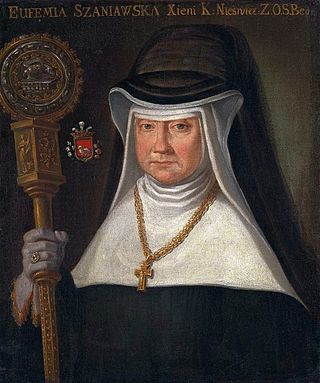
An abbess is the female superior of a community of nuns in an abbey.

The Royal Abbey of Our Lady of Fontevraud or Fontevrault was a monastery in the village of Fontevraud-l'Abbaye, near Chinon, in the former French Duchy of Anjou. It was founded in 1101 by the itinerant preacher Robert of Arbrissel. The foundation flourished and became the centre of a new monastic Order, the Order of Fontevraud. This order was composed of double monasteries, in which the community consisted of both men and women — in separate quarters of the abbey — all of whom were subject to the authority of the Abbess of Fontevraud. The Abbey of Fontevraud itself consisted of four separate communities, all managed by the same abbess.

Eadburh was the daughter of King Edward the Elder of England and his third wife, Eadgifu of Kent. She lived most of her life as a nun known for her singing ability. Most of the information about her comes from hagiographies written several centuries after her life. She was canonised twelve years after her death and there are a small number of churches dedicated to her, most of which are located near Worcestershire, where she lived.

Shaftesbury Abbey was an abbey that housed nuns in Shaftesbury, Dorset. It was founded in about 888, and dissolved in 1539 during the English Reformation by the order of Thomas Cromwell, minister to King Henry VIII. At the time it was the second-wealthiest nunnery in England, behind only Syon Abbey.

Wilton Abbey was a Benedictine convent in Wiltshire, England, three miles west of Salisbury, probably on the site now occupied by Wilton House. It was active from the early tenth century until 1539.
Marie I or Mary was the suo jure Countess of Boulogne from 1159 to 1170. She also held the post of Abbess of Romsey for five years until her abduction by Matthew of Alsace, who forced her to marry him. She is one of several possible identities of the author Marie de France.

Barking Abbey is a former royal monastery located in Barking, in the London Borough of Barking and Dagenham. It has been described as having been "one of the most important nunneries in the country".
Faremoutiers Abbey was an important Merovingian Benedictine nunnery in the present Seine-et-Marne department of France. It formed an important link between the Merovingian Frankish Empire and the southern Anglo-Saxon kingdoms of Kent and East Anglia.

Chelles Abbey was a Frankish monastery founded around 657/660 during the early medieval period. It was intended initially as a monastery for women; then its reputation for great learning grew, and when men wanted to follow the monastic life, a parallel male community was established, creating a double monastery.

Remiremont Abbey was an abbey that was founded as a house of nuns near Remiremont, Vosges, France. It later became a community of secular canonesses.
Ælfgifu of Shaftesbury was the first wife of King Edmund I. She was Queen of the English from her marriage in around 939 until her death in 944. Ælfgifu and Edmund were the parents of two future English kings, Eadwig and Edgar. Like her mother Wynflaed, Ælfgifu had a close and special if unknown connection with the royal nunnery of Shaftesbury (Dorset), founded by King Alfred, where she was buried and soon revered as a saint. According to a pre-Conquest tradition from Winchester, her feast day is 18 May.

Marie Anne Éléonore Gabrielle de Bourbon was a daughter of Louis III de Bourbon, Prince of Condé and Louise Françoise, Princess of Condé. She was the Abbess of Saint-Antoine-des-Champs, an abbey in the Villejuif suburb of Paris.

Élisabeth Charlotte Gabrièle of Lorraine was a Princess of Lorraine. She died of smallpox aged 10. She was the Titular Abbess of Remiremont.

Thorn Abbey or the Imperial Abbey of Thorn was an imperial abbey of the Holy Roman Empire in what is now the Netherlands. It was founded in the 10th century and remained independent until 1794, when it was occupied by French troops. The self-ruling abbey enjoyed imperial immediacy and belonged to the Lower Rhenish-Westphalian Circle.

Marie-Catherine de Beauvilliers was a French abbess.
Eulalia was a French nun who became abbess of the monastery at Shaftesbury in 1074. She is mentioned in a few contemporary documents including a charter in 1089 and a charter of King Stephen. She is also mentioned in the 1122-23 obituary rolls of Vitalis, abbot of Savigny and in the 1113 roll of Matilda, abbess of Caen.
Elizabeth Shelford was abbess of Shaftesbury Abbey from 1505-1528. She was the second-last person to serve as Abbess before the monastery's closure under Henry VIII's dissolution.
Emma was an abbess of Shaftesbury Abbey at the beginning of the 12th century. It is not certain, but it is possible that she was the successor of Eulalia after her death in 1106. A charter of King Henry I of England in 1121-1122 mentions her.
Leofgifu was abbess of Shaftesbury Abbey in Dorset, England during the mid 11th century. She was the last Anglo-Saxon abbess to hold authority over Shaftesbury prior to the changes that occurred in England after the Norman conquest in 1066. Her successor Eulalia was likely of French descent.
Elizabeth Zouche, was an English abbess. She was the last abbess of Shaftesbury Abbey, a Benedictine nunnery founded by Alfred the Great which was one of the largest and richest in England. She signed the deed of surrender on 23 March 1539 which brought the 650 year life of the abbey to an abrupt end and granted all its property and wealth to Henry VIII.












